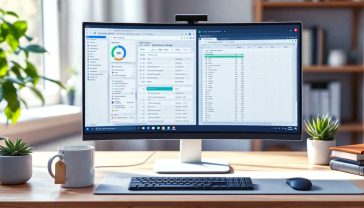The Guide to Ranking Higher on Google: A No-Nonsense Guide for British Businesses
The definitive, no-jargon guide for British businesses on how to get your website ranking higher on Google. Learn the SEO essentials today.

This post may contain affiliate links. If you make a purchase through these links, we may earn a commission at no additional cost to you.
Ever feel like your website is lost in the digital wilderness? You’ve built a brilliant online shop or a slick portfolio, but it’s sitting on page ten of Google, where only the most determined internet explorers dare to venture. It’s a common frustration. You’re left wondering, “How on earth do I get my website higher on Google?”
You’re not alone. Getting to that coveted top spot can feel like trying to find a decent cup of tea in a service station – a real challenge, but not impossible. The good news is that it isn’t some dark art reserved for tech wizards. It’s a process called Search Engine Optimisation (SEO), and it’s something you can absolutely get to grips with.
Think of Google as a librarian for the entire internet. When you type something into its search bar, it scurries off to find the most helpful, trustworthy, and relevant books (or webpages) on that topic. SEO is simply the art of making sure your website is the one the librarian hands over first, with a confident nod and a whisper of, “This is exactly what you were looking for.”
This guide will walk you through everything you need to know, step-by-step. We’ll ditch the confusing jargon and focus on practical, actionable advice that works for businesses right here in the UK. Whether you’re a plumber in Peckham, a baker in Bristol, or a software start-up in Stirling, these principles will help you climb the Google ladder. So, grab a biscuit, settle in, and let’s get your website the attention it deserves.
Part 1: The Foundations – Understanding How Google Works
Before we start tinkering with your website, it’s crucial to understand what’s happening behind the curtain. Google’s goal is simple: to give its users the best possible answers to their questions. To do this, it uses a complex system of automated programs, often called “spiders” or “bots,” to perform three key tasks.
What are Crawling, Indexing, and Ranking?
Imagine you’ve written a fantastic new book. For it to appear in a library, a few things need to happen first. Google’s process is quite similar.
- Crawling: This is the discovery phase. Google’s spiders constantly crawl the web, following links from one page to another to find new or updated content. It’s like a librarian roaming the country, looking for new books to add to their collection. They discover your website by following a link from another site or because you’ve submitted it to them directly.
- Indexing: Once a page is discovered, Google tries to understand what it’s about. It analyses the text, images, and video files on the page, cataloguing and storing this information in a gigantic database called the Google Index. This is like the librarian reading your book, figuring out its genre, themes, and key topics, and then placing it on the correct shelf in the library. If your site isn’t in the index, it simply can’t be found.
- Ranking: This is the moment of truth. When someone types a query into Google, it searches its index for the most relevant pages and then ranks them in order of quality and relevance. The algorithm that determines this order is incredibly complex, considering hundreds of different factors. This is the librarian, upon being asked for a book on “gardening in the UK,” quickly scanning the shelves and recommending the very best, most trusted options first.
Our entire mission is to make sure Google’s spiders can easily find and understand your website (crawling and indexing) and then convince the algorithm that your pages are the best possible answer for what people are searching for (ranking).
A Brief Trip Down Memory Lane: How SEO Has Changed
SEO wasn’t always this sophisticated. In the early days of the internet, back in the late 90s and early 2000s, getting to the top of Google was a bit of a Wild West. People would stuff their pages with keywords – sometimes even making the text invisible by matching it to the background colour! This was called “keyword stuffing,” and for a while, it worked.
But Google quickly got smarter. It realised that just because a page mentioned “cheap holidays in Cornwall” 500 times didn’t mean it was a good resource. Users were getting frustrated with low-quality, spammy results.
So, Google started rolling out major updates to its algorithm, often with quirky names like Panda, Penguin, and Hummingbird. Each update was designed to better understand the quality and intent behind content.
- Panda (2011) targeted “thin” or low-quality content, penalising websites that were just churning out pages for the sake of it.
- Penguin (2012) went after spammy link-building practices, where sites would buy thousands of dodgy links to try and trick Google into thinking they were popular.
- Hummingbird (2013) was a huge leap forward. It helped Google understand the meaning behind a search query, not just the individual words. It could grasp context, so a search for “best place to get coffee near Buckingham Palace” would show you nearby cafes, not just pages that repeated those keywords.
Today, SEO is all about quality, relevance, and user experience. You can’t cheat the system anymore. You have to earn your spot at the top by being genuinely helpful.
Part 2: The Three Pillars of Modern SEO
Think of a successful SEO strategy as a three-legged stool. If one leg is weak, the whole thing will wobble and fall over. These three legs are Technical SEO, On-Page SEO, and Off-Page SEO.
Pillar 1: Technical SEO – Getting Your House in Order
Technical SEO is all about making sure your website is built in a way that search engines can easily crawl and index. It’s the plumbing and wiring of your site. It might sound intimidating, but many of the basics are straightforward.
Why Website Speed Matters More Than Ever
Have you ever clicked on a link and waited… and waited… for the page to load? What did you do? You probably hit the “back” button. We all do. We’re an impatient bunch, and Google knows it.
Page speed is a critical ranking factor. A slow website not only frustrates visitors but also tells Google that the user experience is poor. In 2021, Google introduced the Core Web Vitals, a set of specific metrics that measure user experience, including loading speed, interactivity, and visual stability.
- How to check your speed: You can use Google’s own free tool, PageSpeed Insights. Just pop in your website address, and it will give you a score for both mobile and desktop, along with suggestions for improvement.
- Common culprits of a slow site: Large, uncompressed images are a major offender. A beautiful, high-resolution photo from a professional camera can be several megabytes in size, which takes ages to download. Using a simple online tool like TinyPNG can shrink image file sizes without sacrificing much quality. Other issues can include clunky code or a slow web hosting provider.
The Importance of Being Mobile-Friendly
Take a look around you on the bus, in a cafe, or even just walking down the street. How many people are on their phones? Today, more Google searches happen on mobile devices than on desktop computers.
Because of this, Google now operates on a “mobile-first indexing” basis. This means it primarily uses the mobile version of your website for indexing and ranking. If your site looks great on a laptop but is a jumbled mess on a phone – where you have to pinch and zoom to read anything – you’re going to have a big problem.
A responsive design is the solution. This is where your website automatically adjusts its layout to fit the screen it’s being viewed on. Most modern website builders, like Squarespace, Wix, or WordPress themes, have this built-in. You can check if your site is mobile-friendly using another free tool from Google: the Mobile-Friendly Test.
Secure Your Site with HTTPS
Have you ever noticed the little padlock icon in the address bar of your browser? That means the site is using HTTPS (Hypertext Transfer Protocol Secure). It encrypts the data being sent between your browser and the website, protecting sensitive information like passwords or credit card details.
Google wants to send its users to safe and secure websites, so having HTTPS is a confirmed, albeit small, ranking signal. More importantly, most modern browsers like Chrome will show a “Not Secure” warning for sites that don’t use it, which can scare visitors away.
Getting an HTTPS certificate (often called an SSL certificate) used to be expensive and complicated, but today, most good web hosting companies, like Kinsta or SiteGround, offer them for free. It’s a simple switch to make for a big gain in trust.
Creating a Logical Site Structure with an XML Sitemap
A good website is like a well-organised shop. You have clear aisles and signs pointing customers to what they need. A confusing website is like a jumble sale – people will quickly get frustrated and leave.
A logical site structure helps both users and Google’s spiders find their way around. Pages should be organised into clear categories. For example, a bakery in Birmingham might structure its site like this:
- Homepage
- About Us
- Our Breads
- Sourdough
- Rye Bread
- Baguettes
- Our Cakes
- Birthday Cakes
- Wedding Cakes
- Contact Us
This clear hierarchy makes navigation easy. To help Google understand this structure even better, you can create an XML sitemap. This is essentially a map of all the important pages on your website, created specifically for search engines. Most SEO plugins for WordPress, like Yoast SEO or Rank Math, can generate one for you automatically.
Pillar 2: On-Page SEO – Crafting Perfect Content
On-Page SEO involves optimising the actual content on your webpages. This is where you show Google what your pages are about and prove that you’re an expert on the topic.
Keyword Research: Reading Your Customers’ Minds
Everything in SEO starts with keywords. These are the words and phrases that people type into Google when they’re looking for something. To rank high, you need to figure out what those phrases are and create content that answers them. This process is called keyword research.
- Think Like a Customer: The first step is to brainstorm. If you were a customer looking for your business, what would you search for? Let’s say you’re a dog groomer in Manchester. You might start with:
- “dog groomer manchester”
- “dog clipping near me”
- “best poodle groomer manchester”
- “how much to groom a cockapoo”
- Understand User Intent: Notice the different types of searches above.
- “dog groomer manchester” is transactional – the person is looking to hire someone.
- “how much to groom a cockapoo” is informational – the person is looking for information. Your website should have content that serves both intents. You need a service page targeting “dog groomer manchester” and perhaps a blog post or FAQ page answering the cost question.
- Use Keyword Research Tools: Brainstorming is great, but tools can give you real data. They can tell you how many people are searching for a term each month (search volume) and how difficult it might be to rank for (keyword difficulty).
- Free tools: Google Keyword Planner (you need a Google Ads account, but you don’t have to spend money) and Ubersuggest (offers a limited number of free searches per day) are good starting points.
- Paid tools: Services like Ahrefs, SEMrush, and Moz are the industry standard, offering incredibly detailed data, but they come with a monthly subscription fee.
- Focus on “Long-Tail Keywords”: Short keywords like “cakes” are very broad and incredibly competitive. But a longer, more specific phrase like “vegan birthday cake delivery london” is a “long-tail keyword.” Fewer people search for it, but the person who does is highly motivated and knows exactly what they want. It’s much easier to rank for these specific phrases.
Creating High-Quality, E-E-A-T Content
Once you have your keywords, you need to create content that deserves to rank. Google’s quality standards are summed up by the acronym E-E-A-T:
- Experience: Show that you have first-hand, real-life experience with the topic. If you’re writing a review of a lawnmower, have you actually used it?
- Expertise: Demonstrate your knowledge and skill in the field. A qualified accountant writing about tax returns has more expertise than a random blogger.
- Authoritativeness: This is about your reputation. Are you seen as a go-to source of information in your industry? Do other experts link to your work?
- Trustworthiness: Be honest and transparent. Provide clear contact information, cite your sources, and secure your website with HTTPS.
For topics that could impact a person’s health, finances, or safety – what Google calls “Your Money or Your Life” (YMYL) topics – E-E-A-T is extremely important.
So, what does high-quality content look like?
- It’s genuinely helpful: It solves a problem or answers a question thoroughly.
- It’s well-written and easy to read: Use short sentences and paragraphs. Break up text with headings, bullet points, and images.
- It’s unique: Don’t just copy and paste information from other websites. Offer your own unique perspective, insights, or data.
- It’s comprehensive: Cover the topic in depth. A good blog post about “how to choose a running shoe” would cover foot type, running surface, different brands, and how to get properly fitted.
Optimising Your Page Elements
Once you’ve written your brilliant content, you need to make sure you place your main keyword in a few key places to signal its relevance to Google.
- Title Tag: This is the headline that appears in the Google search results and in the browser tab. It’s arguably the most important on-page SEO element. It should be compelling and include your primary keyword, ideally near the beginning. For example:
**Best Dog Groomers in Manchester** | Fluffy Pups & Co. - Meta Description: This is the short snippet of text that appears under your title tag in the search results. It doesn’t directly affect rankings, but a good one entices people to click on your link over a competitor’s. Think of it as a mini-advert for your page.
- Headings (H1, H2, H3): Use headings to structure your content. Your main page title should be an H1 tag. Subheadings should be H2s, and further sub-sections H3s. Include your primary keyword in the H1 and variations of it in some of your H2s. This helps Google understand the hierarchy and main topics of your page.
- Image Alt Text: Alt text (alternative text) is a short description of an image. It’s used by screen readers for visually impaired users and is also what Google reads to understand what an image is about. It’s a great place to include a relevant keyword. Instead of an alt text like “IMG_1234.jpg,” use something descriptive like “a white standard poodle being groomed at our Manchester salon.”
Pillar 3: Off-Page SEO – Building Your Reputation
Off-Page SEO refers to actions taken outside of your own website to impact your rankings. It’s largely about building your site’s authority and reputation, primarily through earning links from other websites.
The Power of Backlinks
Backlinks are links from other websites to yours. Google sees them as votes of confidence. If a reputable, well-respected website like the BBC or The Guardian links to your article, it’s a massive signal to Google that your content is trustworthy and valuable.
Quality over quantity is the rule here. One high-quality link from an authoritative site is worth more than a thousand low-quality links from spammy directories.
So, how do you get these valuable links?
- Create “Link-Worthy” Content: This is the foundation of any good link-building strategy. You need to create content that people want to link to. This could be:
- A groundbreaking piece of research or a unique industry survey.
- A comprehensive, ultimate guide to a topic.
- A free tool or calculator that is genuinely useful.
- A visually stunning infographic that simplifies a complex topic.
- Guest Posting: This involves writing an article for another website in your industry. In return, you usually get a link back to your own site in your author bio. It’s a great way to get your name out there and build authority. Look for reputable blogs in your niche that accept guest contributions.
- Digital PR: This is about getting your business mentioned in online news articles and publications. You could create a press release about a new product, an interesting company story, or some unique data you’ve collected. If a journalist from a local paper like the Manchester Evening News or a national outlet writes about you and links to your site, that’s a powerful backlink.
- Broken Link Building: This is a clever tactic. You find a resource page on another website that links out to other sites. You then use a tool (like the Ahrefs Broken Link Checker) to see if any of those links are “broken” (i.e., they lead to a page that no longer exists). You can then email the site owner, politely point out the broken link, and suggest they replace it with a link to your similar, but up-to-date, resource.
What to avoid: Never, ever buy links. This is a direct violation of Google’s guidelines, and if you’re caught, your site can be heavily penalised or even removed from the search results entirely.
Part 3: Putting It All Together – Local SEO and Measuring Success
For many British businesses, attracting local customers is the main goal. If you’re a cafe in Cardiff, you don’t care about ranking in Carlisle. This is where Local SEO comes in.
Winning the Local Game with Google Business Profile
If you’ve ever searched for something like “plumber near me,” you’ve seen the “map pack” – a map with three local business listings underneath it. Getting into this prime real estate can be a game-changer for a local business.
The key to this is your Google Business Profile (GBP), formerly known as Google My Business. This is a free profile that allows you to manage how your business appears on Google Search and Maps.
Optimising your GBP is one of the highest-impact things you can do for local SEO.
- Claim and Verify Your Profile: First, go to google.com/business and search for your business name. If a profile already exists, you’ll need to claim it. If not, you can create one. Google will need to verify that you’re the legitimate owner, usually by sending a postcard with a code to your physical business address.
- Fill Out EVERYTHING: Be as thorough as possible. Add your business name, address, phone number (make sure these are consistent everywhere online!), opening hours, website, services, and photos. The more information you provide, the better.
- Choose the Right Categories: Be specific. Instead of just “restaurant,” choose “Italian Restaurant” or “Vegan Restaurant.”
- Encourage Customer Reviews: Reviews are a massive local ranking factor. They provide social proof and show Google that you’re a legitimate, active business. Actively ask your happy customers to leave a review. And be sure to respond to all reviews, both positive and negative. It shows you care.
- Use Google Posts: This feature lets you share short updates, offers, or event news directly in your profile. It’s a great way to keep your listing fresh and engaging.
Tracking Your Progress: How to Know If It’s Working
SEO is a marathon, not a sprint. It can take several months to see significant results, so it’s important to track your progress to know what’s working.
- Google Search Console: This is a free and essential tool from Google. It gives you a wealth of information about your site’s health and performance in Google Search. You can see which queries are bringing people to your site, check for any technical errors (like pages that can’t be crawled), and submit your sitemap. You absolutely must set this up.
- Google Analytics: Another free and indispensable tool. While Search Console tells you what happens before someone clicks on your site, Analytics tells you what happens after. You can see how many people are visiting your site, where they’re coming from, which pages are most popular, and how long they’re staying.
- Rank Tracking: While you can manually check your rankings, it’s not very reliable as Google personalises results. Rank tracking tools (many paid SEO suites offer this, or there are dedicated tools like SERPWatcher) will automatically check your position for your target keywords every day, giving you a clear picture of your progress over time.
Conclusion: Your Journey to the Top of Google
Getting your website higher on Google is not about finding a magic bullet or a secret trick. It’s about consistently applying a set of proven principles over time. It’s about building a technically sound website, filling it with genuinely helpful and expert content, and earning a reputation as a trusted authority in your field.
Start with the foundations. Get your technical house in order by focusing on speed, mobile-friendliness, and security. Dive deep into keyword research to truly understand your customers and what they’re looking for. Then, create content that doesn’t just answer their questions but delights them with its depth and quality. Finally, work on building your authority through earning high-quality backlinks and dominating your local search results with a perfectly optimised Google Business Profile.
It can feel like a lot to take in at first, but don’t be overwhelmed. Start small. Pick one thing from this guide to work on this week. Maybe it’s compressing the images on your homepage or optimising the title tag of your most important service page.
Every small improvement is a step up the ladder. By focusing on providing a fantastic experience for your users, you’ll also be giving Google exactly what it wants. And in time, you’ll see your website climb the rankings, bringing you more visitors, more customers, and the success your business deserves.
Further Reading
For those who want to dive even deeper, here are some of the most respected resources in the SEO industry:
- Google Search Central Blog: Straight from the source, Google’s own blog for SEOs and webmasters.
- Moz Blog: A fantastic resource for beginners and experts alike, covering all aspects of SEO.
- Ahrefs Blog: In-depth, data-driven articles and case studies on SEO and content marketing.
- Search Engine Journal: A leading source for daily news and guides on SEO and digital marketing.






